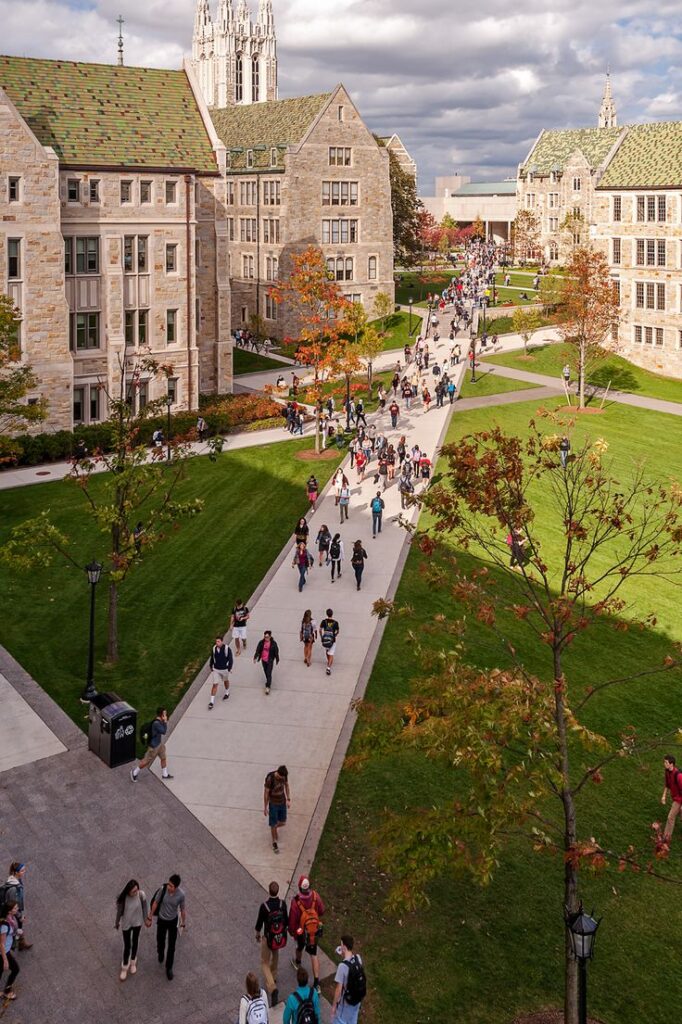Stands for “Campus Area Network.” A CAN is a network that covers an educational or corporate campus. Examples include elementary schools, university campuses, an corporate buildings.
Campus Area Networks (CANs):
A campus area network is larger than a local area network LAN since it may spar multiple buildings within a specific area. Most CANs are comprised of several LAN connected via switches and routers that combine to create a single network. They operate similar to LANs, in that users with access to the network (wired or wireless can communicate directly with other systems within the network.)

A college or university CAN may also be called a “residential network” or “Reshe” since it can only be accessed by campus residents, such as students and faculty.
The two primary benefits of a CAN are security and speed:
Security:
Unlike a wide area network (WAN), a CAN Ís managed and maintained by a sine entity, such as the campus IT team. The network administrators can monitor, a the Internet to protect the network from unauthorized access. A firewall or server may also be used to limit the websites or Internet ports users can access.

Speed:
speeds between systems within the network are often higher than typical Internet Since communication within a CAN takes place over a local network, data transfer speeds, This makes it easy to share large files with other users on the network For example, it may take several hours to upload a long video to a colleague over the Internet, but the transfer may only take a few minutes over a CAN,
Internet Service Providers:
How to work Internet service provides?
An Internet service provider (ISP) is a company that provides customers with Internet access. Data may be transmitted using several technologies, including dial-up, DSL, cable modem, wireless or dedicated high-speed interconnects.
An Internet service provider (ISP) is a company that provides customers with Internet access. Data may be transmitted using several technologies, including dial-up, DSL, cable modem, wireless or dedicated high-speed interconnects.
Typically, ISPs also provide their customers with the ability to communicate with one another by providing Internet email accounts, usually with numerous email addresses at the customer’s discretion. Other services, such as telephone and television services, may be provided as well. The services and service combinations may be unique to each ISP.

Individual customers and businesses pay ISPs for Internet Access. ISPs are interconnected to one another at network access points. In turn, ISPs pay other, larger ISPs for their Internet access, which in turn pay still other ISPs.
This cascades multiple times until transmissions reach a Tier 1 carrier, which is an ISP capable of reaching every other network on the Internet without purchasing IP transit or paying settlements. However, it is difficult to determine the status of a network because the business agreements to pay settlements are not made public.
An Internet service provider is also known as an Internet access provider (IAP).
The Internet began as a closed network between government research laboratories and universities and colleges. As universities and colleges began giving Internet access to their faculty and other employees, ISPs were created to provide Internet access to those employees at home and elsewhere. The first ISP began in 1990 as The World, based in Brookline, Massachusetts.
However, the situation is more complex than simply a single connection established to an upstream ISP. ISPs may have more than one point of presence (Pop), which is an access point to the Internet comprised of a physical location housing servers, routers, ATM switches and digital/analog call aggregators. Some ISPs have thousands of Pops. Multiple Pops may have separate connections to an upstream ISP. And each ISP may have upstream ISPs and connections to each one of them at one or multiple Pops.
Internet and Extranets:
Definition of Internet:
The Internet is a global network of computing systems which are connected to each other and help in providing information to everyone who has access, When a web address is entered, the internet makes use of internet protocol address which tells the exact location of the computer, where it is present.
From there it gets the information from sets of devices known as the web server which can have a domain name and an address which is then displayed with the help of a browser. It has a basic level security and does not have firewalls to protect it. There is no requirement of the password to use it and people anywhere, who have the availability of a computer can get all the information which they require.
An intranet is a platform which works on the same principals as the internet but is accessible to the outer world. It is unique to an organization such as universities which have information provided and can be viewed within the premises of the Institute. The entire computers are connected with each other and have no connection with the outer world.
When the intranet is connected to the internet, it will be protected with another level of security in the form of the firewall so that on particular people can reach it. To simplify it is a network on the computer which works without depending on the internet. There are files of intranet present inside the computer which help in gaining all the information without depending on the internet
Definition of Extranet:
An Extranet is best explained as a network which depends on the internet but is restricted to specific users. It is more accurate than intranet in a way that only a few people instead of a particular place can get access. It is protected by a firewall and if the intranet is accessed from the internet to send or receive information it becomes an extranet It is mostly used by business and companies who have to share sensitive data with each other.
The firewall is used to switch between internet and intranet and lets only the people who can log in with the help of passwords or by internet protocol addresses. It can be used by individuals or a group of folks depending on the level of requirement
Key Differences:
- 1 The Internet isa global network which is available to anyone who wants to access information. An intranet is unique to an organization or group of people who wok together data place. Extranet is for individuals or group of personnel who want to send private information.
- 2. The Internet isa private network, the intranet is independent in its own way, but a extranet is dependent on internet and intranet.
- 3. The Internet does not have firewall protection: the intranet can have firewall protection while extranet always has firewall protection.
- 4 The Internet is used to gain general information. An intranet is used to share an accurate Extranet is used to send and receive private information.
- 5. The Internet is called a public domain, Intranet is known as a particular area extranet is called private domain.
- 6. The Internet can be used without any personal account. Intranet sometimes can require a login while extranet always requires a login.
The Internet and the web Features:
E-mail:
Email, short for “electronic mail,” is one of the most widely used features of the Internet, along with the web. It allows you to send and receive messages to and from anyone with an email address, anywhere in the world.
Email uses multiple protocols within the TCP/IP suite. For example, SMTP is used to send messages, while the POP or IMAP protocols are used to retrieve messages from a mail server. When you configure an email account, you must define your email address, password, and the mail servers used to send and receive messages.

Fortunately, most webmail services configure your account automatically, so you only need to enter your email address and password.
However, if you use an email client like Microsoft Outlook or Apple Mail, you may need to manually configure each account. Besides the email address and password, you may also have to enter the incoming and outgoing mail servers and enter the correct port numbers for each one.
The original email standard only supported plain text messages. Eventually, email evolved to support rich text with custom formatting. Today, email supports HTML, which allows emails to be formatted the same way as websites.
HTML email messages can include images, links, and CSS layouts. You can also send files or “email attachments” along with messages. Most mail servers allow you to send multiple attachments with each message, but they limit the total size. In the early days.
Email Netiquette:
When composing an email message, it is important to use good netiquette example, you should always include a subject that summarizes the topic of the email It is also helpful to begin each message with the recipient’s name and end the message with your name or “signature.” A typical signature includes your name, email address and/or website URL A professional signature may include your company name and title as well. Most email programs allow you to save multiple signatures, which can insert at the bottom of an email.
If you want to send an email to multiple recipients, you can simply add each email address to the “To” field. However, if the email is primarily intended for one person you should place the additional addresses in the “CC” (carbon copy) field. If you are sending an email to multiple people that don’t know each other, it is best to use the “Bcc” (blind carbon copy) field. This hides the email addresses of each recipient which helps prevent spam.
NOTE: Email was originally written “e-mail,” but is now more commonly written as “email” without the dash.
In conclusion –
Stands for “Campus Area Network.” A CAN is a network that covers an educational or corporate campus. Examples include elementary schools, university campuses, an corporate buildings. A campus area network is larger than a local area network LAN since it may spar multiple buildings within a specific area. Most CANs are comprised of several LAN connected via switches and routers that combine to create a single network.
What is the difference between Internet and Extranets?
The Internet is a global network of computing systems which are connected to each other and help in providing information to everyone who has access, When a web address is entered, the internet makes use of internet protocol address which tells the exact location of the computer, where it is present.
An Extranet is best explained as a network which depends on the internet but is restricted to specific users.
New Post
Follow on Twitter





